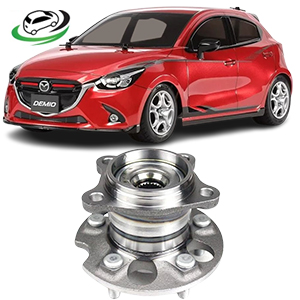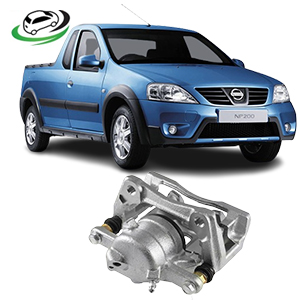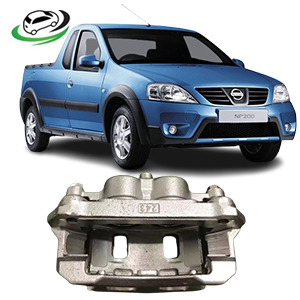Get Nissan NP200 Front Brake Caliper RHS 41001-00Q0E
The front brake caliper on the Nissan NP200, specifically the right-hand side (RHS), plays a critical role in the vehicle’s braking system. As a vital component, it works in conjunction with the brake pads, rotors, and hydraulic system to ensure the vehicle can come to a safe and controlled stop. Below is an in-depth explanation of the front brake caliper, its functions, benefits, common issues, and maintenance tips for the Nissan NP200.
1. What is a Brake Caliper?
A brake caliper is a component of a disc brake system, which is a common braking system used in modern vehicles, including the Nissan NP200. Its primary role is to house the brake pads and pistons. The caliper presses the brake pads against the brake rotor, creating friction that slows the rotation of the wheel, allowing the vehicle to decelerate or come to a full stop.
There are two main types of brake calipers:
- Floating (or sliding) calipers, where the caliper moves back and forth over the rotor.
- Fixed calipers, which do not move and instead have pistons on both sides of the rotor.
For the Nissan NP200, a sliding caliper is typically used, as it is common in vehicles designed for daily utility purposes.
2. Function of the Front Brake Caliper
The front brake calipers are integral to the braking process. Here’s how the caliper operates:
- Hydraulic Pressure Activation: When the driver presses the brake pedal, brake fluid (usually DOT 4) is sent from the master cylinder to the brake caliper through hydraulic lines.
- Piston Movement: The hydraulic pressure causes the caliper’s pistons to move, pushing the brake pads against the rotor.
- Friction Creation: The contact between the brake pads and the rotor generates friction. This friction converts the kinetic energy of the moving vehicle into heat, slowing down the wheel’s rotation, thereby bringing the vehicle to a stop.
- Release: When the brake pedal is released, the hydraulic pressure drops, causing the pistons to retract and the brake pads to move away from the rotor. This ensures that the wheels can rotate freely again.
3. Design of the Nissan NP200 Front Brake Caliper
The Nissan NP200 front brake caliper (RHS) is a single-piston floating caliper, meaning it uses one piston that presses the brake pad on one side of the rotor, while the caliper body moves to apply pressure on the opposite pad. This design is cost-effective and efficient for vehicles like the NP200, which are designed for everyday driving and light commercial use.
Key components of the caliper include:
- Caliper Body: The main housing that holds the pistons and brake pads.
- Pistons: These are metal or ceramic cylinders that push the brake pads against the rotor.
- Caliper Bracket: The caliper is attached to the vehicle’s suspension via a mounting bracket.
- Brake Pads: Friction materials that are pressed against the brake rotor to create the necessary friction.
- Guide Pins: These allow the caliper to slide, ensuring even wear on the brake pads.
- Seals and Boots: These protect the internal components of the caliper from dirt, water, and brake fluid leakage.
4. Benefits of a Properly Functioning Front Brake Caliper
A properly functioning front brake caliper is crucial for several reasons:
- Safety: The caliper ensures that the brake pads are applied with the correct force, providing reliable stopping power.
- Performance: A healthy caliper provides smooth and consistent braking, allowing the vehicle to stop quickly when needed.
- Longevity of Brake Components: When functioning correctly, the caliper ensures even wear on the brake pads and rotors, extending their lifespan and reducing the need for frequent replacements.
- Fuel Efficiency: Well-maintained calipers ensure that the brakes release properly when not in use, preventing brake drag, which can negatively impact fuel efficiency.
5. Common Issues with Brake Calipers
Like all mechanical components, brake calipers can develop issues over time. Common problems with the Nissan NP200 front brake caliper (RHS) include:
- Caliper Sticking: This occurs when the caliper does not release the brake pads properly, causing them to remain in contact with the rotor. This results in brake drag, overheating, and premature wear of the pads and rotors.
- Leaking Brake Fluid: The seals within the caliper can wear out, leading to brake fluid leaks. A loss of brake fluid reduces hydraulic pressure, making it harder for the caliper to press the pads against the rotor, which can lead to brake failure.
- Uneven Pad Wear: If the caliper’s guide pins become stuck, the brake pads may wear unevenly, reducing braking efficiency and leading to premature pad replacement.
- Corrosion: Exposure to moisture and road salts can cause the caliper to rust, especially in older vehicles or those used in harsh environments.
6. Maintenance of the Front Brake Caliper
Proper maintenance of the front brake calipers can prevent many of the issues mentioned above. Some essential maintenance practices include:
- Regular Inspections: It is recommended to visually inspect the brake calipers during routine service intervals. Look for signs of leaks, corrosion, and uneven pad wear.
- Brake Fluid Check: Brake fluid is crucial to the caliper’s operation. Make sure the brake fluid is at the correct level and that it is not contaminated. Nissan recommends replacing brake fluid every 30,000 miles or as per the owner’s manual.
- Lubrication of Guide Pins: The guide pins should be lubricated with a high-temperature brake grease to prevent sticking and ensure smooth caliper operation.
- Replacing Worn-Out Pads and Rotors: Ensure that brake pads and rotors are replaced when worn out. Running with worn pads can damage the caliper pistons and result in poor braking performance.
- Caliper Rebuild or Replacement: If the caliper is sticking or leaking fluid, it may need to be rebuilt or replaced. Rebuild kits are available, which include new seals and pistons, or a complete replacement caliper may be necessary depending on the severity of the wear.
7. Installation of a New Brake Caliper (RHS)
If the front brake caliper on the right-hand side of your Nissan NP200 needs to be replaced, here is an overview of the installation process:
- Prepare the Vehicle: Lift the vehicle and remove the wheel to access the brake assembly.
- Remove the Old Caliper: Unbolt the caliper from the mounting bracket and disconnect the brake hose.
- Install the New Caliper: Mount the new caliper onto the bracket, reattach the brake hose, and tighten all bolts to the manufacturer’s specifications.
- Bleed the Brakes: After installation, the brake system must be bled to remove any air bubbles that may have entered the system during the caliper replacement.
- Test the Brakes: Once everything is in place, test the brakes to ensure proper operation.
8. Conclusion
The front brake caliper on the Nissan NP200, particularly the right-hand side, is a critical component in the braking system. Its role in pressing the brake pads against the rotors ensures that the vehicle can stop safely and efficiently. Proper maintenance, including regular inspections, lubrication, and timely replacement of worn components, will ensure the longevity and reliability of the brake calipers, enhancing both the safety and performance of the Nissan NP200.
Follow us on Facebook for more parts.



